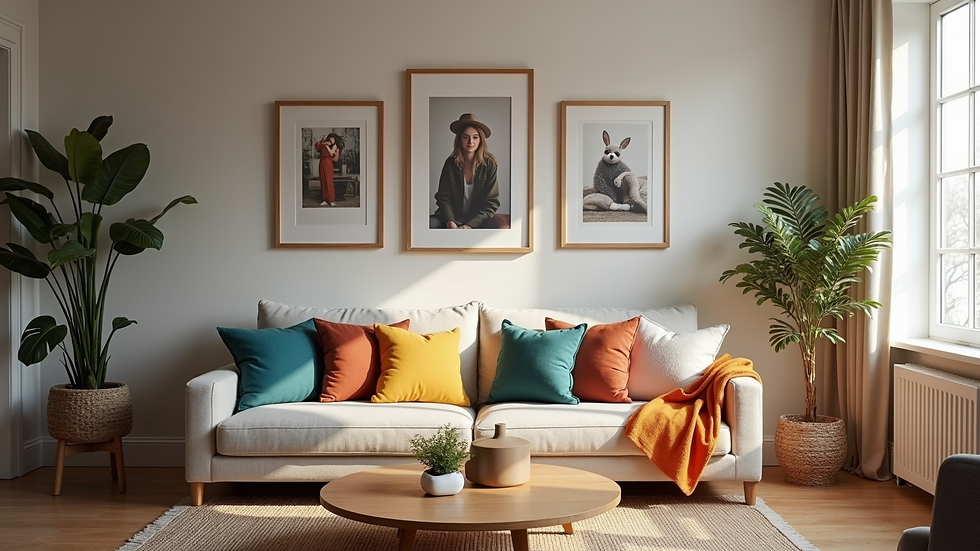Eco-Friendly Interior Design Trends for 2023
- kristinavozarova04
- Nov 3
- 4 min read
Sustainability is no longer just a buzzword in interior design. In 2023, eco-friendly choices have become essential for creating beautiful, functional spaces that respect the planet. More homeowners and designers are turning to materials, methods, and styles that reduce environmental impact without sacrificing style or comfort. This post explores the top trends shaping eco-friendly interior design this year, offering practical ideas you can use to make your home greener and more inviting.

Using Natural and Reclaimed Materials
One of the strongest trends in eco-friendly design is the use of natural and reclaimed materials. These choices reduce waste and avoid the environmental costs of producing new materials.
Reclaimed wood is popular for flooring, furniture, and accent walls. It adds warmth and character while keeping old wood out of landfills.
Bamboo grows quickly and regenerates easily, making it a sustainable alternative for flooring, cabinetry, and decorative items.
Natural stone and clay tiles offer durability and a timeless look without synthetic chemicals.
Recycled glass is increasingly used in countertops and backsplashes, combining beauty with sustainability.
Choosing these materials supports circular design principles and often results in unique, one-of-a-kind pieces.
Energy-Efficient Lighting and Fixtures
Lighting accounts for a significant portion of home energy use. In 2023, energy-efficient lighting is a must-have for eco-friendly interiors.
LED bulbs use up to 80% less energy than traditional incandescent bulbs and last much longer.
Smart lighting systems allow you to control brightness and schedules, reducing unnecessary energy consumption.
Fixtures made from recycled or sustainable materials add an eco-conscious touch to your lighting choices.
Maximizing natural light through window placement and light-colored walls reduces the need for artificial lighting during the day.
These strategies lower energy bills and reduce your carbon footprint.
Indoor Plants for Air Quality and Aesthetics
Indoor plants are more than decoration. They improve air quality by filtering toxins and increasing oxygen levels. In 2023, integrating greenery into interiors is a key trend.
Choose low-maintenance plants like snake plants, pothos, and spider plants that thrive indoors.
Use vertical gardens or living walls to maximize green space in small areas.
Combine plants with natural materials like wood and stone for a cohesive, earthy look.
Consider plants that also help regulate humidity, such as peace lilies.
Plants create a calming atmosphere and connect indoor spaces with nature.
Non-Toxic Paints and Finishes
Traditional paints and finishes often contain volatile organic compounds (VOCs) that harm indoor air quality. Eco-friendly interiors now prioritize non-toxic options.
Look for low-VOC or zero-VOC paints certified by reputable organizations.
Use natural oils and waxes for wood finishes instead of chemical-based products.
Choose fabrics and upholstery treated with natural dyes and free from harmful chemicals.
These choices protect your health and reduce environmental pollution.
Non-toxic finishes maintain a fresh, clean indoor environment.
Minimalism with Purpose
Minimalism continues to influence eco-friendly design, but with a focus on purpose and quality rather than just aesthetics.
Select multi-functional furniture that reduces clutter and the need for extra pieces.
Invest in durable, timeless items instead of fast furniture that wears out quickly.
Emphasize open spaces and natural light to create a sense of calm and simplicity.
Use neutral, earthy color palettes that complement sustainable materials.
This approach reduces waste and encourages mindful consumption.
Upcycling and DIY Projects
Upcycling old furniture and decor is a creative way to embrace sustainability.
Transform worn-out chairs with new upholstery made from recycled fabrics.
Repurpose wooden pallets into shelves or coffee tables.
Use leftover paint to create accent walls or art pieces.
DIY projects reduce demand for new products and add personal character to your space.
Upcycling supports a circular economy and reduces landfill waste.
Smart Home Technology for Sustainability
Smart home devices help monitor and reduce energy and water use.
Install smart thermostats to optimize heating and cooling.
Use water-saving fixtures with sensors to prevent waste.
Monitor energy consumption with smart plugs and meters.
Automate lighting and appliances to run only when needed.
Technology makes sustainable living easier and more efficient.
Sustainable Textiles and Fabrics
Textiles play a big role in interior design, and sustainable choices are gaining traction.
Choose fabrics made from organic cotton, hemp, or linen grown without pesticides.
Look for recycled polyester or blends that reduce plastic waste.
Avoid synthetic dyes and opt for natural or plant-based dyes.
Support brands that follow ethical production practices.
Sustainable textiles add comfort and style while protecting the environment.
Water Conservation Features
Water-saving design elements are essential for eco-friendly interiors.
Use low-flow faucets and showerheads to reduce water use.
Install dual-flush toilets that save water with every flush.
Incorporate greywater recycling systems to reuse water for irrigation.
Choose plants that require minimal watering for indoor gardens.
These features conserve a precious resource and lower utility bills.
Biophilic Design Elements
Biophilic design connects people with nature through architecture and decor.
Use natural shapes and patterns inspired by plants and landscapes.
Incorporate natural light and ventilation to improve well-being.
Add water features like small indoor fountains for calming effects.
Use earthy colors and textures that evoke natural environments.
This design philosophy supports mental health and creates inviting spaces.
Eco-friendly interior design in 2023 blends style with responsibility. By choosing natural materials, energy-efficient lighting, indoor plants, and sustainable textiles, you create spaces that are both beautiful and kind to the planet. Small changes like using non-toxic paints or upcycling furniture add up to a big impact. Embrace these trends to build a home that supports your lifestyle and the environment.
Start by assessing your current space and identifying one or two sustainable upgrades you can make today. Whether it’s swapping out light bulbs or adding a few plants, every step counts toward a greener home.


Comments